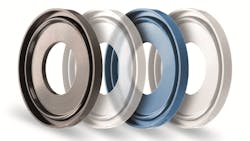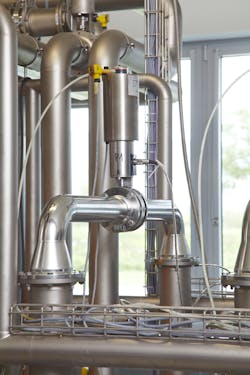5 best practices when selecting sealing solutions for food and beverage applications
Selecting the best sealing solution for any industry application can be a complex challenge. That complexity only intensifies when choosing seals used in food and beverage processing, as the assignment can become especially intricate due to many factors that must be considered.
Food and beverage production and processing requires a high degree of cleanliness and hygiene in industrial operations. The materials used in the processing equipment must not release any chemicals into the foodstuffs, should be unaffected by ingredient and flavor-absorption/transfer, and prevent leaks or other malfunctions that could expose products to contamination.
Standards regulating which raw material ingredients are approved for food and beverage applications have been established throughout the world but can vary by region. Further, sealing materials used in the production process must be able to withstand aggressive media such as cleaning agents, greases and extreme high and low temperatures.
To help lay out a roadmap for those handling this task, here are five best practices to consider when selecting sealing solutions for food and beverage applications.
1. Where will the seal be used?
Before asking any other questions, this should be inquiry number one. Today’s global industry means engineering for multiple markets and diverse regulatory compliance standards, which can be challenging and expensive to certify, so it must be considered early.
In order to guarantee the safe consumption of food, the design and material composition of sealing solutions must comply with legal requirements, such as the European EU (VO) 1935/2004, the U.S. Food and Drug Administration (FDA) §177.2600 or the Chinese GB 4806 and GB 9685. At the same time, the sealing components must also meet the hygienic design standards of the EHEDG (European Hygienic Engineering and Design Group).
The GB 4806 and GB 9685 standards that have been enforced in China for food and beverage applications are different from relevant U.S. and EU regulations. For example, the ingredients that may be contained in a seal in contact with a product, as listed in the GB 9685 standard, differ significantly.
The list of chemical ingredients permitted for use in China does not include a significant number of chemicals that are compliant with FDA and EU regulations for elastomers, resulting in a limited portfolio of sealing options for products that will be distributed worldwide.
In cases where the limited existing sealing options for global distribution do not fit the bill, a new material formulation from a sealing supplier may need to be requested. However, the cost to test and certify a new material recipe in all regions annually can become quite expensive.
The complexity of food and beverage regulations — and the potential need to develop alternate ingredient formulas — should be a key consideration when sourcing a sealing manufacturer. Companies that do not routinely monitor regulatory changes can cost customers time and money. Likewise, companies that do not routinely conduct comprehensive material testing may find the process of eliminating and replacing a single banned ingredient difficult and lengthy.
2. What fluids/foods will the seal be exposed to?
While this sounds simple enough on the surface, the answer usually goes well beyond simply identifying the product being manufactured. Long-term exposures to certain ingredients can negatively impact equipment performance if the correct sealing materials are not used. Dairy products such as milk and ice cream, plus certain oils, often require different types of sealing materials for performance and regulatory compliance. The production of carbonated sodas and other flavored beverages often contain concentrated syrups that can be highly acidic.
In addition, the possibility of flavor transfer with certain products should be considered, whether during the production process or at the point of purchase for consumption. For example, soft drink manufacturers rarely have separate, dedicated production lines for every single flavor of beverage they produce. Instead, a line will operate for a set amount of time dispensing one drink flavor, before being stopped and cleaned to switch over to a different flavor. The sealing materials used on such line equipment should be resistant to flavor absorption to not only prevent against cross-flavor contamination but also to help reduce the amount of time a production line needs to remain idle for cleaning between flavor shifts.
In addition, the types of cleaners and sanitizers involved in the manufacturing process of certain products must also be considered, along with the frequency and duration of the cleaning process itself. Even when equipment is only briefly exposed to sanitizing chemicals, the chemicals and/or the cleaning process are typically basic solutions and can be highly aggressive.
3. What is the seal expected to do?
To select the correct sealing solution, requirements for how the seal will perform in a specific environment must be evaluated. Such analysis routinely necessitates looking beyond material and product specifications to the actual use factors involved in food and beverage systems.
For example, does the process require a static seal, such as an O-ring, that will be used to simply fill gaps and prevent leaks with minimal relaxation? Does it mandate the use of a dynamic rotating seal that needs to be flexible enough during motion to prevent leaks and resist wear and abrasion? How flexible does it need to be at low temperatures? Will the sealing part be bonded to metal or plastic? Will multiple fluids be using a common nozzle? Will the seal be used on a filling system, a pump, a valve or a mixer?
One common material may not be the best solution for every seal type in your application. Working with a sealing supplier that offers a wide-ranging portfolio of solutions can be the best bet to ensure you are able to review plenty of options for your needs.
4. Temperature exposure — both high and low
When it comes to the temperature conditions in which food and beverages are processed, both extremes need to be considered.
Elevated temperatures typically will accelerate chemical reactions and material attack. Steam used in the sterilization process is often more aggressive than the food or beverage product itself. Therefore, the material compatibility plan should consider the actual temperature conditions reached.
On the other end of the temperature spectrum, extreme cold temperatures can cause seals to become brittle and crack, leading to failure and potential contamination issues. In addition, low operating temperatures can greatly affect dynamic seals that need to be able to bend and move within an application. A dynamic seal that has become too stiff will not follow the sealing surface and leak.
5. Customer expectations
Even when dealing with process manufacturing customers that produce similar products, each customer may have different expectations when it comes to seal performance, even within the same region and the same regulations.
How does each customer define lifetime performance? What do they consider to be heavy-duty conditions? Where have they encountered issues before? What is their production and cleaning schedule like?
Sealing solutions that offer a longer lifetime or that can be used in global applications across different regions may come with a higher initial price tag, but the benefits can outweigh the cost long-term for customers that require them. Multiple materials would not need to be certified and validated if a global compound is used.
Is your customer willing to invest more to have a longer lasting seal? Do they have a history of being proactive when it comes to maintenance and regularly replacing worn sealing components? The cost of a service call is always more than the replacement part. Each customer will have its own unique metrics to consider.
David Clark, P.E., is a senior staff chemist for Freudenberg Sealing Technologies. He is an expert in the development of prototype elastomer materials for diverse industries including automotive, aerospace, food and beverage and energy. Clark supports manufacturing sites with production scale-up, process development, troubleshooting and failure analysis. He holds a master’s degree in materials science engineering from the University of Michigan and a bachelor’s degree in chemical engineering from Michigan State University.
About the Author
David Clark
Senior staff chemist for Freudenberg Sealing Technologies
David Clark, P.E., is a senior staff chemist for Freudenberg Sealing Technologies. He is an expert in the development of prototype elastomer materials for diverse industries including automotive, aerospace, food and beverage and energy. Clark supports manufacturing sites with production scale-up, process development, troubleshooting and failure analysis. He holds a master’s degree in materials science engineering from the University of Michigan and a bachelor’s degree in chemical engineering from Michigan State University.


